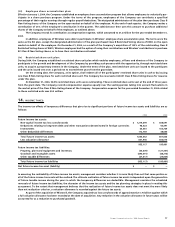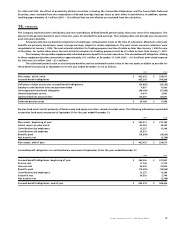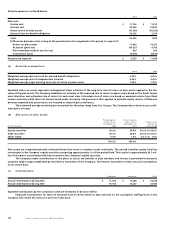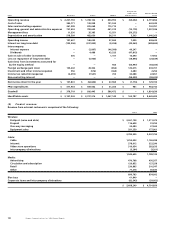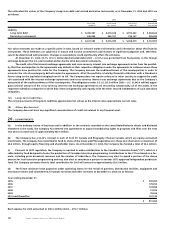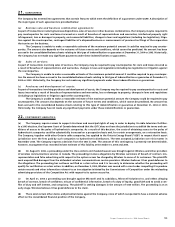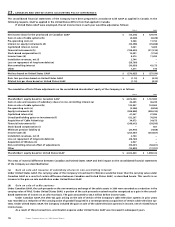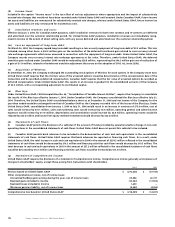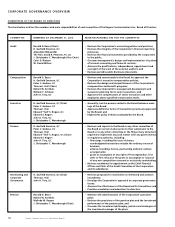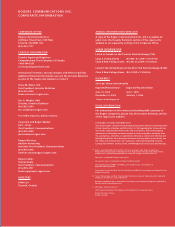Rogers 2004 Annual Report Download - page 109
Download and view the complete annual report
Please find page 109 of the 2004 Rogers annual report below. You can navigate through the pages in the report by either clicking on the pages listed below, or by using the keyword search tool below to find specific information within the annual report.
107
Rogers Communications Inc. 2004 Annual Report
(c) Pre-operating costs:
Under Canadian GAAP, the Company defers the incremental costs relating to the development and pre-operating phases of new busi-
nesses and amortizes these costs on a straight-line basis over periods up to five years. Under United States GAAP, these costs are
expensed as incurred.
(d) Equity instruments:
Under Canadian GAAP, the Convertible Preferred Securities are classified as shareholders’ equity and the related interest expense is
recorded as a distribution from retained earnings. Under United States GAAP, these securities are classified as long-term debt and the
related interest expense is recorded in the consolidated statements of income.
(e) Capitalized interest:
United States GAAP requires capitalization of interest costs as part of the historical cost of acquiring certain qualifying assets that
require a period of time to prepare for their intended use. This is not required under Canadian GAAP.
(f) Unrealized holding gains and losses on investments:
United States GAAP requires that certain investments in equity securities that have readily determinable fair values be stated in the
consolidated balance sheets at their fair values. The unrealized holding gains and losses from these investments, which are considered
to be “available-for-sale securities” under United States GAAP, are included as a separate component of shareholders’ equity and com-
prehensive income, net of related future income taxes.
(g) Acquisition of Cable Atlantic:
United States GAAP requires that shares issued in connection with a purchase business combination be valued based on the market
price at the announcement date of the acquisition, whereas Canadian GAAP had required such shares be valued based on the market
price at the consummation date of the acquisition. Accordingly, the Class B Non-Voting shares issued in respect of the acquisition of
Cable Atlantic in 2001 were recorded at $35.4 million more under United States GAAP than under Canadian GAAP. This resulted in an
increase to goodwill in this amount, with a corresponding increase to contributed surplus in the amount of $35.4 million.
(h) Financial instruments:
Under Canadian GAAP, the Company accounts for certain of its cross-currency interest rate exchange agreements as hedges of specific
debt instruments. Under United States GAAP, these instruments are not accounted for as hedges, but instead changes in the fair value
of the derivative instruments, reflecting primarily market changes in foreign exchange rates, interest rates, as well as the level of short-
term variable versus long-term fixed interest rates, are recognized in income immediately. Foreign exchange translation gains and
losses arising from change in period-end foreign exchange rates on the respective long-term debt are also recognized in income.
Under United States GAAP, as a result of the adoption of United States Financial Accounting Standard Board’s (“FASB”) Statement
(“SFAS”) No. 133, “Accounting for Derivative Instruments and Hedging Activities” (“SFAS 133”) effective January 1, 2001, the Company
recorded a cumulative transition adjustment representing the adjustment necessary to reflect the derivatives at their fair values at that
date, net of the offsetting gains/losses on the associated hedged long-term debt. This cumulative transition adjustment is being
reflected in income over the remaining term of the related long-term debt. In March 2004, $11.4 million of this cumulative transition
adjustment was written off as a result of the repayment of the long-term debt to which it relates (note 23(m)).
(i) Stock-based compensation:
Under Canadian GAAP, effective January 1, 2004, the Company adopted the fair value method of recognizing stock-based compensation
expense. For United States GAAP purposes, the intrinsic value method is used to account for stock-based compensation of employees.
Compensation expense of $15.1 million recognized under Canadian GAAP would not be recognized under United States GAAP for the
year ended December 31, 2004. The exercise price of stock options is equal to the market value of the underlying shares at the date of
grant, therefore, there is no expense under the intrinsic value method for United States GAAP purposes for the year ended December 31,
2004 and 2003.
Effective January 1, 2004, the Blue Jays were determined to be a variable interest entity for United States GAAP purposes and, as
a result, their results were consolidated from that date (note 23(o)). As such, the employees of the Blue Jays were considered employees
of the Company effective January 1, 2004 for United States GAAP purposes. The intrinsic value of the options of Blue Jays’ employees
was calculated as at January 1, 2004 as nil. Prior to 2004, the Blue Jays’ employees were not considered employees of the Company.
Therefore, compensation expense of $1.2 million for the year ended December 31, 2003 under United States GAAP was determined using
the fair value method.
(j) Minimum pension liability:
Under United States GAAP, the Company is required to record an additional minimum pension liability for one of its plans to reflect the
excess of the accumulated benefit obligation over the fair value of the plan assets. Other comprehensive income has been charged with
$8.5 million (2003 – $5.0 million), which is net of income taxes of $4.6 million (2003 – $2.9 million). No such adjustments are required
under Canadian GAAP.


